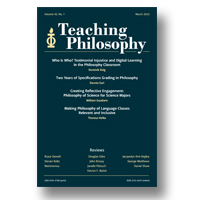|
articles |
|
21.
|
Teaching Philosophy:
Volume >
47 >
Issue: 1
Elizabeth Scarbrough
Examining Monuments:
Digital Humanities in the Philosophy Classroom
abstract |
view |
rights & permissions
| cited by
How can philosophers incorporate the Digital Humanities into their classrooms? And why should they? In this paper, I explore answers to these questions as I detail what I have dubbed “The Monuments Project'' and describe how this project engages with Digital Humanities and teaches students to connect theoretical philosophical concepts with their lives. Briefly, the Monuments Project asks students to apply concepts discussed in our philosophy class (in my case, a Global Aesthetics class) with a monument in their environment. Instead of a traditional paper, students upload MP3s of their observations, pictures and/or drawings of the monument, and text-based responses. The goal of the Monument Project is twofold: to get students to connect what they have learned to a sense of place - the place where they live, and to introduce them to the Digital Humanities.
|
|
|
|
|
22.
|
Teaching Philosophy:
Volume >
47 >
Issue: 1
Cheng-chih Tsai
Logic for the Field of Battle
abstract |
view |
rights & permissions
| cited by
The truth table method, natural deduction, and the truth tree method, the three validity proving methods standardly taught in an introductory logic course, are too clumsy for the battlefield of real-life. The “short truth table” test is handy at times, but it stumbles at many other times. In this paper, we set up a general method that can beat all the methods mentioned above in a contest of speed. Furthermore, the procedure can be step-by-step paraphrased in a natural language, so that, unlike the other methods, a real-life logical problem can be analyzed and explained in a real-life language too.
|
|
|
|
|
23.
|
Teaching Philosophy:
Volume >
47 >
Issue: 1
S. K. Wertz
Mixing and Matching Deductive and Non-deductive Arguments:
Lessons in Applied Logic
abstract |
view |
rights & permissions
| cited by
This essay is basically divided into two parts. The first deals with the similarities between reductio ad absurdum arguments and slippery slope arguments. The chief example comes from Thomas Hobbes’s Leviathan, which advances an argument for the necessity of government for humane living. The second addresses some pedagogical concerns centered around another pair of arguments: the argument by complete enumeration and the argument by inductive generalization. The illustration for this pair comes from the arts. I finish with a suggestion that pairs like the above can be as effectively used in shorter, non-regular critical reasoning or introductory logic courses as those in mid-term or summer courses. Such pairing can demonstrate a good use of mixing and matching deductive and non-deductive arguments in teaching logic.
|
|
|
|
|
book reviews |
|
24.
|
Teaching Philosophy:
Volume >
47 >
Issue: 1
Erica Bigelow
Practical Bioethics: Ethics for Patients and Providers, by J. K. Miles
view |
rights & permissions
| cited by
|
|
|
|
|
25.
|
Teaching Philosophy:
Volume >
47 >
Issue: 1
Henri Cilliers, Kiasha Naidoo
The Buddha’s Teachings as Philosophy, by Mark Siderits
view |
rights & permissions
| cited by
|
|
|
|
|
26.
|
Teaching Philosophy:
Volume >
47 >
Issue: 1
Samuel Duncan
Being Good in a World of Need, by Larry Temkin
view |
rights & permissions
| cited by
|
|
|
|
|
27.
|
Teaching Philosophy:
Volume >
47 >
Issue: 1
Robert Earle
Tenacious Beasts: Wildlife Recoveries That Change How We Think about Animals, by Christopher J. Preston
view |
rights & permissions
| cited by
|
|
|
|
|
28.
|
Teaching Philosophy:
Volume >
47 >
Issue: 1
Jacob D. Hogan
Modern Moral Philosophy: From Grotius to Kant, by Stephen Darwall
view |
rights & permissions
| cited by
|
|
|
|
|
29.
|
Teaching Philosophy:
Volume >
47 >
Issue: 1
Jeremiah Joven Joaquin
Logical Methods, by Greg Restall and Shawn Standefer
view |
rights & permissions
| cited by
|
|
|
|
|
30.
|
Teaching Philosophy:
Volume >
47 >
Issue: 1
Isadora Monteiro
Philosophy of Science and the Kyoto School: An Introduction to Nishida Kitaro, Tanabe Hajime and Tosaka Jun, by Dean Anthony Brink
view |
rights & permissions
| cited by
|
|
|
|
|
31.
|
Teaching Philosophy:
Volume >
47 >
Issue: 1
Edward H. Spence
Choosing Freedom: A Kantian Guide to Life, by Karen Stohr
view |
rights & permissions
| cited by
|
|
|
|
|
32.
|
Teaching Philosophy:
Volume >
47 >
Issue: 1
Clint Tibbs
How to Think Like a Philosopher: Twelve Key Principles for More Humane, Balanced, and Rational Thinking, by Julian Baggini
view |
rights & permissions
| cited by
|
|
|
|
|
33.
|
Teaching Philosophy:
Volume >
47 >
Issue: 1
Furkan Yazıcı
Mind Design III: Philosophy, Psychology, and Artificial Intelligence, edited by John Haugeland, Carl F. Craver, and Colin Klein
view |
rights & permissions
| cited by
|
|
|
|
